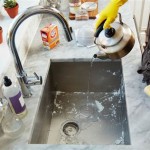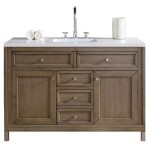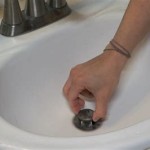Bathroom Vanity Cabinet: Single Sink Considerations
The selection of a bathroom vanity cabinet with a single sink is a crucial design decision that impacts both the aesthetics and functionality of a bathroom space. This article explores the multifaceted aspects of choosing the right single sink vanity, encompassing dimensions, materials, styles, installation considerations, and the overall impact on bathroom design. By understanding these elements, homeowners and renovators can make informed choices that optimize their bathroom environment.
Understanding Dimensions and Space Constraints
Accurate measurement of the available space is paramount before initiating the search for a bathroom vanity cabinet. The dimensions should encompass the width, depth, and height of the intended installation area. Understanding these measurements prevents the selection of a vanity that is too large or too small for the designated space. Consider the existing plumbing configurations and door swing clearances to ensure a seamless integration of the new vanity.
A common mistake is focusing solely on the vanity’s dimensions while neglecting the surrounding features. The space around the vanity must be adequate for comfortable movement and use. Leave sufficient room for opening drawers and cabinet doors fully without obstruction. Account for the proximity of the toilet, shower, or bathtub to prevent cramped conditions.
Small bathrooms benefit from compact vanity designs. Options like corner vanities or wall-mounted vanities can maximize floor space and create a more open feel. Larger bathrooms can accommodate larger, more elaborate vanities that provide ample storage and counter space. The key is to strike a balance between functionality and spatial harmony.
The height of the vanity is another crucial dimension to consider. Standard vanity heights typically range from 30 to 36 inches. However, "comfort height" vanities, which are taller (around 36 inches), are becoming increasingly popular for their ergonomic advantages. Taller vanities can reduce strain on the back and knees during daily use, making them a desirable option for individuals with mobility concerns or those seeking enhanced comfort.
Material Selection and Durability
The material composition of a bathroom vanity cabinet directly affects its durability, longevity, and resistance to moisture. Bathrooms are inherently humid environments, making moisture-resistant materials essential for preventing damage and prolonging the vanity's lifespan.
Solid wood, particularly hardwoods like oak, maple, and cherry, offer excellent durability and a classic aesthetic. However, solid wood is susceptible to moisture damage if not properly sealed and maintained. Regular sealing and proper ventilation are necessary to prevent warping, swelling, and cracking.
Plywood is a common and cost-effective alternative to solid wood. High-quality plywood, constructed with multiple layers of wood veneer bonded together, offers considerable strength and stability. Plywood is less prone to warping than solid wood and can be treated with moisture-resistant coatings to enhance its performance in a bathroom setting. It's important to specify "marine-grade" plywood for superior water resistance in extremely humid bathroom environments.
Medium-density fiberboard (MDF) is another engineered wood product commonly used in vanity construction. MDF is made from wood fibers bonded together with resin, resulting in a smooth, uniform surface. While MDF is less expensive than solid wood or plywood, it is more susceptible to moisture damage. MDF vanities should be carefully sealed and protected from water exposure to prevent swelling and disintegration.
Beyond the core material, the finish applied to the vanity plays a crucial role in protecting it from moisture. Painted finishes, stained finishes with a protective topcoat, and laminate surfaces are all common options. The chosen finish should be durable, water-resistant, and easy to clean.
Countertop materials also significantly influence the overall durability and aesthetic appeal of the vanity. Common countertop options include granite, marble, quartz, solid surface materials, and laminate. Each material offers unique characteristics in terms of durability, maintenance requirements, and cost.
Style and Aesthetic Considerations
The style of the bathroom vanity cabinet should complement the overall design aesthetic of the bathroom. There is a wide range of styles available, from traditional and classic to modern and contemporary. Choosing a style that aligns with the existing fixtures, tiling, and color scheme creates a cohesive and visually appealing bathroom environment.
Traditional vanities often feature ornate details, raised panel doors, and decorative hardware. These vanities evoke a sense of elegance and sophistication, often incorporating elements of classic furniture design. Traditional vanities are typically crafted from solid wood and finished with rich stains or painted in classic colors.
Modern vanities are characterized by clean lines, minimalist designs, and a focus on functionality. They often feature slab-front doors, integrated hardware, and sleek, contemporary finishes. Modern vanities may incorporate materials such as glass, metal, and engineered stone to create a sophisticated and streamlined look.
Contemporary vanities blend elements of both traditional and modern styles. They may feature clean lines with subtle ornamentation or incorporate modern materials with classic design elements. Contemporary vanities offer a versatile option that can adapt to a variety of bathroom styles.
Beyond the overall style, the color of the vanity can significantly impact the bathroom's ambiance. Light-colored vanities can create a sense of spaciousness and brightness, while dark-colored vanities can add depth and sophistication. Neutral tones, such as white, gray, and beige, are versatile options that can complement a wide range of color schemes.
Hardware selection is an often-overlooked detail that can significantly enhance the vanity's aesthetic appeal. Knobs, pulls, and handles should complement the vanity's style and finish. Consider coordinating the hardware with other bathroom fixtures, such as faucets and showerheads, to create a cohesive look.
Installation and Plumbing Considerations
Proper installation is critical for ensuring the longevity and functionality of a bathroom vanity cabinet. While some homeowners may opt for DIY installation, professional installation is generally recommended, particularly for complex plumbing configurations or modifications.
Before installation, ensure that the water supply lines and drainpipes are properly located and in good working condition. Shut off the water supply to the bathroom before disconnecting the old vanity and preparing for the new installation. Verify that the floor is level to prevent wobbling or unevenness of the vanity.
If the new vanity has different plumbing connections than the old vanity, modifications to the existing plumbing may be necessary. This may involve extending or rerouting pipes, which should be performed by a qualified plumber. Ensure that all plumbing connections are properly sealed to prevent leaks.
When installing a wall-mounted vanity, it is essential to ensure that the wall is adequately reinforced to support the vanity's weight. Use appropriate mounting hardware and follow the manufacturer's instructions carefully. If necessary, consult with a contractor to ensure that the wall can safely support the vanity.
After installation, inspect all plumbing connections for leaks. Turn on the water supply and check for any drips or seepage. If leaks are detected, tighten connections or replace faulty components as needed. Ensure that the sink drain is properly connected and draining freely.
Allow adequate ventilation around the vanity to prevent moisture buildup. Ensure that the bathroom is properly ventilated with an exhaust fan to remove excess humidity and prevent mold growth. Regularly clean and maintain the vanity to prolong its lifespan and preserve its appearance.
Choosing the right single sink bathroom vanity involves careful consideration of multiple factors, including dimensions, materials, style, and installation requirements. By thoughtfully addressing these elements, homeowners can select a vanity that not only enhances the aesthetic appeal of their bathroom but also provides lasting functionality and value.

Ariel Hamlet 55 In White Undermount Single Sink Bathroom Vanity With Quartz Top The Vanities Tops Department At Com

Classic 55 Single Sink Vanity Pottery Barn

Ari Kitchen And Bath Lauren 55 In Single Vanity Weathered Fir With Marble Top Carrara White Basin Akb Weathfir The Home

Ariel Taylor 55 In White Undermount Single Sink Bathroom Vanity With Quartz Top The Vanities Tops Department At Com

Ariel Hamlet 55 In Black Undermount Single Sink Bathroom Vanity With White Quartz Top The Vanities Tops Department At Com

Dkb Hartford 55 In Single Sink Vanity Set White Decorativekitchenbath

Roma Single 55 Inch Transitional Bathroom Vanity Espresso
Belmont Decor Bdv055sovlwht Hampton 55 Inch Single Sink Vanity With Oval Bdv055sovlgry

Ariel Kensington 55 In W X 22 D 35 25 H Freestanding Bath Single Sink Vanity White With Marble Top D055scw2ovowht The Home

Ari Kitchen And Bath Marina 55 In Single Vanity Driftwood With Marble Top Carrara White Basin Akb 55dw The Home







